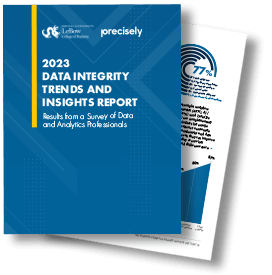In today’s highly digitized world, data is a strategic asset. It’s no longer sufficient to extract value from your data opportunistically. To remain competitive, you must proactively and systematically pursue new ways to leverage data to your advantage.
As the value of data reaches new highs, the fundamental rules that govern data-driven decision-making haven’t changed. To make good decisions, you need high-quality data. You need to know what you have, its lineage, where it’s located, and which business rules determine its structure, content, and validity. If your data quality is low or if your data assets are poorly governed, then you simply won’t be able to use them to make good business decisions.
As the role of data and data-driven decision-making increases and as the overall volume and velocity of available data grows, data governance is evolving to meet a changing set of business requirements. What are the biggest trends in data governance for 2024? Here are the developments gaining steam in the coming year.
1. A New Era of Data Governance
Data governance is alive and well, having shifted from a “nice to have” function to a mainstream necessity – a “must” for any enterprise wanting to leverage data to its advantage.
Why? Because the stakes are higher than ever before. There are huge benefits to be gained by optimizing an organization’s access to information assets and advancing its mastery of data on the whole.
At the same time, multiple factors are driving increased complexity. The ongoing digitization of business processes and digital consumer interactions combine with a rich tapestry of geospatial information and demographic data to create an abundance of new opportunities to create business value. Meanwhile, regulatory complexity generates a range of new challenges, requiring you to understand and control the information in your care.
All this leads to an increasingly urgent new set of needs. You must now know:
- What data your organization has
- Where it’s located
- What is its lineage
- What kinds of business rules govern it
- What is the data definition according to who owns it
- How to make data accessible to the users who can drive business value from it
As a formal discipline, data governance continues to evolve and so does the terminology around it. The more mainstream it becomes, the more we see data governance being rolled into the categories of “active metadata management” and “augmented data quality”; it’s simply become an assumption that’s part of any data quality or excellence initiative.
This impact of data governance was clear in the 2023 Data Integrity Trends and Insights Report, published in partnership between Precisely and Drexel University’s LeBow College of Business. Of the more than 450 data and analytics professionals surveyed, those with a data governance program in place report:
- improved quality of data analytics and insights (57%)
- improved data quality (55%)
While the language around data governance may be changing, its fundamental elements are stronger and more needed than ever – serving a range of increasingly important functions in this era of powerful data analytics, artificial intelligence (AI), and machine learning (ML). That’s why enterprises around the world are forging ahead with data governance programs and programmatically seeking to achieve higher levels of data integrity.
2. Without Data Governance, AI Remains a Huge Liability
Everyone’s talking about AI. In software, AI technology provides a unique ability to automate or accelerate user tasks, which results in greater efficiency and productivity, as well as a reduced dependence on manual labor.
When it comes to generative AI, there’s been an unexpectedly astronomical rise in the usage among everyday consumers over the past year, sparked by the launch of ChatGPT in November 2022.
This transformational technology has the world buzzing, and AI’s potential continues to grow. But what does that mean as it relates to data governance and the bigger picture of data integrity?
AI without data governance is a huge liability. That’s because governance answers questions like:
- “What’s the lineage of this data – where did it come from?”
- “What’s the quality?”
- “Do I have the right to use it?”
- “How fresh is it?”
Without this information that boosts data understanding, you risk compromising your AI initiatives due to unreliable insights and biases that don’t fuel business value.
But with data integrity, and data governance in particular, you reduce risk and liability while gaining more trustworthy and dependable AI results. That means you’re set up for confident data-driven decisions that help you grow the business, move quickly, reduce costs, and manage risk and compliance.

3. The Need for Governance of Data and Analytics Increases
77% of data and analytics professionals say data-driven decision-making is the top goal of their data programs. And in today’s competitive landscape, those decisions need to be made fast.
That makes it easy to see why the demand for governance of data and analytics is rapidly on the rise – users want to quickly and easily discover, understand, and trust their data, and to have the ability to self-serve in real time. Then, they can get to data-driven analysis and decision-making faster.
With this upward demand for self-service, we’ll see data marketplaces grow in popularity. These marketplaces provide users with easy access to datasets that are certified, current, and ready for use with the appropriate ownership and lineage available. This drives demand to learn more about executing data mesh and/or data fabric strategies to identify and package data products for data consumption.
2023 Data Integrity Trends & Insights
Results from a Survey of Data and Analytics Professionals

4. Data Democratization Drives Bottom-Up Change
To maximize the business value organizations can generate from data assets, enterprises strive to improve data literacy throughout their organizations and increase self-service access to analytics tools and data.
A rising trend we see within data democratization is that enterprises are finding exponential value in integrated solutions. Converging capabilities across data governance, data quality, and more proves more efficient and cost-effective than working with different vendors and separate products that don’t talk to each other. This is especially crucial in times of economic downturn when a “do more with less” mindset becomes a necessity.
Without effective data governance, data democratization introduces a host of potential new risks. As you push forward to increase data access and literacy, for example, you also increase the probability that data might be misinterpreted or deliberately misused.
It’s one thing to make data available to front-line users, offering new opportunities for innovation throughout the organization. It’s quite another matter to ensure that the data you make available to such a broad population of users is fit for purpose, that stakeholders understand how it was collected and used, and that you appropriately control access to the data.
Metadata management offers a foundation for understanding the data that exists across an enterprise and is a prerequisite for using it effectively. Metadata is often referred to as “data about data.” Data governance requires the ability to organize metadata in a data catalog and connect it with a business glossary to establish a truly detailed understanding of the data and how to use it effectively. This fusion of metadata with a business glossary catalog enables you to translate technical data lineage into clearly understandable business lineage.
Without this framework in place, front-line business users may easily go astray, lacking a complete understanding of how the organization’s data might be used effectively.
For data democratization to work, it first needs this layer of business-friendly data governance.
5. Compliance Management Calls for Increased Discipline
Another key driver is an increasingly stringent regulatory environment. Laws like Europe’s General Data Protection Regulation (GDPR) and the California Consumer Privacy Act (CCPA) have been in effect for years now, and environmental, social, and governance (ESG) initiatives continue to be areas of focus. Data sovereignty has also become increasingly important, as national governments consider the implications of hosting certain types of data outside of their own borders. As litigation makes its way through the courts, the real-world implications of compliance continue to evolve.
Regulation isn’t the only factor driving privacy concerns. Members of the public are increasingly cognizant of just how much personal data companies maintain about them, and misused or compromised information leads to bad publicity and broken customer relationships. Companies that take a proactive, disciplined approach toward data governance maintain a clear advantage over those that do not.
Most other compliance requirements benefit greatly from good data governance practices as well. Organizations that manage data effectively are well-positioned to deliver timely and accurate reports to the governments and private entities whose job it is to validate compliance with published standards. If your data is well governed, the cost of compliance can also be significantly.
These five trends and more are continuously driving enterprises to focus their attention on data governance and the many benefits it provides. For even more insights into the state of data governance and data integrity at large, read the 2023 Data Integrity Trends and Insights Report.







